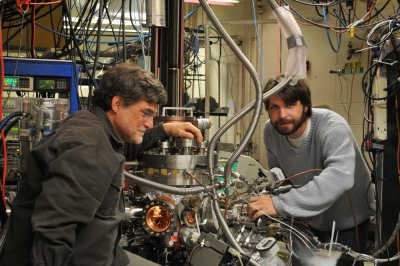Chemists in the US have demonstrated a definitive link between the size of catalyst particles on a solid surface, their electronic properties and their ability to accelerate a chemical reaction. The study could help improve the design of yet more-efficient catalysts to reduce energy requirements for countless industrial processes and cut greenhouse gas emissions.
Ideally, catalysts are substances that speed chemical reactions without themselves being consumed in the reaction. In reality, they are never 100 percent efficient, can be degraded by repeated reaction cycles, and often become poisoned by by-products. Nevertheless, they are at the heart of thousands of chemical reactions used to make everything from pharmaceuticals to plastics.
“One of the big uncertainties in catalysis is that no one really understands what size particles of the catalyst actually make a chemical reaction happen,” says Scott Anderson of the University of Utah. “If we could understand what factors control activity in catalysts, then we could make better and less expensive catalysts.”
Catalysts are commonly made from rare metals including, gold, rhodium, palladium, and platinum, and there is typically a range of catalyst particle sizes present. In almost all cases, the size of the most active particles is unknown. In gold catalysts, which have been intensively studied recently, it has been shown that the bulk of the metal in a catalyst powder exists in the form of particles that are too big to do any catalysis, and only a small fraction of the metal is active.
“If you could make a catalyst with only the right size particles, you could save 90 percent of the cost or more,” asserts Anderson. He also points out that switching to cheaper and more common metals, such as zinc, nickel, and copper, and “tuning” their properties would also let chemists reduce costs significantly. The process of tuning such base metals would involve reducing the particle size until it reaches a catalytic optimum, which is the focus of the Utah team’s work.
Previous work showed how to alter electronic and chemical properties of a catalyst in a gas, but things are different once the particles are mounted on a metal oxide surface for real-life industrial processes.

In the new study, Anderson and his students took a step toward tuning catalysts to have desired properties. In work with Bill Kaden and William Kunkel, and Tianpin Wu, the team has demonstrated, for the first time, that the size of palladium metal catalyst “nanoparticles” deposited on a titanium dioxide surface affects not only the catalyst’s level of activity in converting carbon monoxide to carbon dioxide, but also the particles’ electronic properties.
As the size of a catalyst metal particle is reduced to the nanoscale, its properties initially remain the same as bulk metal. However, when the particles are just 10 nanometres across (containing 10,000 atoms or so) the movements of electrons in the metal become confined, so boosting their energy.
When there are fewer than about 100 atoms in catalyst particles, the size variations also result in fluctuations in the electronic structure of the catalyst atoms. Those fluctuations strongly affect the particles’ ability to act as a catalyst, Anderson says.
The study not only showed how catalytic activity varies with catalyst particle size, “but we have been able to correlate that size dependence with observed electronic differences in the catalyst particles,” Kaden adds. “People had speculated this should be happening, but no one has ever seen it.”